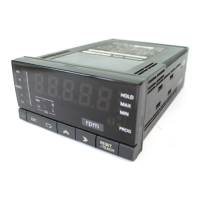129
Appendix B
Estimated Frequency Calculation
If input pulses are suddenly interrupted, the estimated frequency calculation function continuously estimates the
frequency in preparation for the next pulse that may occur. This function ensures improved response to any pulse
occurring within the time period represented by the shaded area of the accompanying graph.
Frequency
Estimated frequency calculation
Time
Estimated frequency calculation graph:
Input pulse
Frequency
Estimated
frequency
calculation
The input frequency cannot be calculated with pulse P0 only. Therefore, the result remains 0. With pulse P1, T1
(from P0 to P1) is measured as one cycle, and the input frequency is calculated from 1/T1. With pulse P2, if T1 is
larger than T2 (if the input frequency increases, i.e. the cycle is shorter), 1/T2 is adopted as the input frequency at
that moment. If no pulse is detected for the T2 period after P2, the new input frequency cannot be known until the
next pulse is detected. The estimated value is 1/T3 if no pulse is detected for period T3. If P3 is detected at that
time, the input frequency then is 1/T3. Therefore the K3NR produces a fast and accurate response as a result of its
estimate. It is better to estimate the input frequency than to keep the frequency, 1/T2, until pulse P3 is actually
detected. With this function, the K3NR can react to sudden changes in the input frequency.

